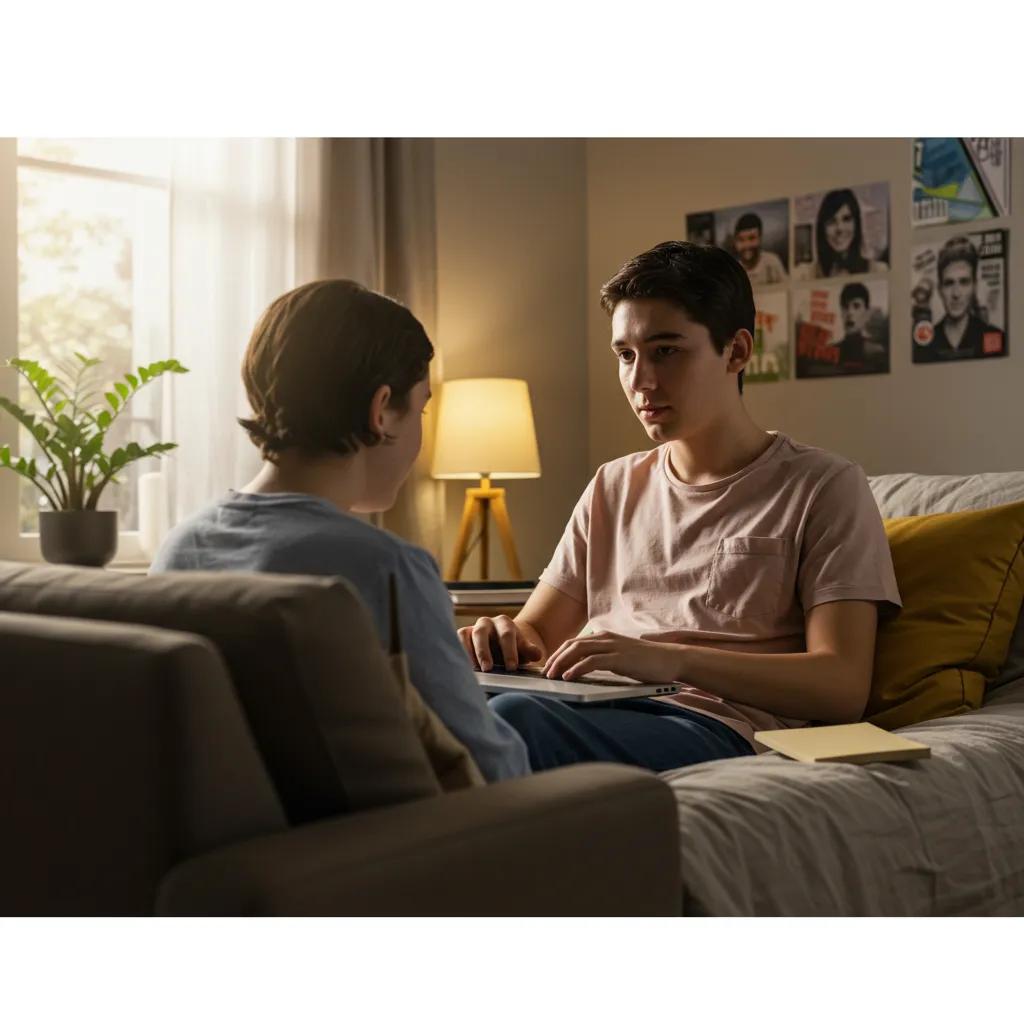How to Build Trust in Online Therapy for Teens: Effective Strategies for Virtual Mental Health
Building trust in online therapy for teens means creating a safe, reliable space where adolescents feel heard, protected, and motivated to engage in treatment. This article explains what trust looks like in virtual counseling, why it matters developmentally for ages 12–17, and practical steps teens and parents can take to strengthen therapeutic alliance.
You will learn how confidentiality is maintained in telehealth, which therapist qualifications matter, how parents can support without overstepping, and why structured Virtual Intensive Outpatient Programs (IOPs) can be especially trustworthy. The guidance blends developmental context, technology safeguards, and concrete checklists so families can evaluate options confidently. Throughout, expect actionable tips, short lists for quick scanning, and easy-to-ask questions to bring to any provider conversation.
Why Is Building Trust Essential in Online Therapy for Adolescents?
Trust in online therapy is the foundation that allows teens to disclose feelings, practice coping skills, and follow through with treatment recommendations. When adolescents believe the virtual setting is private and therapists understand their developmental needs, engagement and symptom improvement increase. Trust also helps overcome telehealth-specific barriers such as tech glitches or worries about peers finding out. Below are three quick benefits that summarize why clinicians prioritize trust for teen telehealth.
- Enhanced honesty: teens share sensitive topics when they feel safe.
- Better adherence: consistent attendance and skill practice improve outcomes.
- Reduced dropout: a reliable alliance lowers the chance of ending therapy early.
These benefits explain why clinicians emphasize confidentiality and rapport-building early in treatment, which leads into the specific developmental reasons trust is so important for teenagers.
What Makes Trust Important for Teens in Virtual Counseling?
Adolescents are negotiating identity, peer norms, and privacy, so trusting a virtual therapist means they can safely explore thoughts and behavior without fearing social consequences. Teens often worry about peer judgment or parental reactions, and clear boundaries around confidentiality let them test ideas and emotions in session. A therapist who uses age-appropriate language and validates autonomy typically fosters faster rapport. This developmental fit makes it more likely the teen will try new coping skills and return for follow-up sessions.
How Does Trust Impact Therapy Outcomes for Youth?
A strong therapeutic alliance predicts better outcomes across depression, anxiety, and behavioral health by improving attendance, motivation, and skill generalization outside sessions. Trust enables collaborative goal-setting and more honest symptom reporting, which sharpens clinical decision-making. In telehealth, consistent scheduling and prompt therapist responses further reinforce reliability and treatment momentum. Those factors together increase the likelihood of measurable symptom reduction and longer-term resilience.
What Are Common Teen Concerns About Online Therapy Trust?
Teens commonly worry that sessions can be overheard, that data might be shared without consent, or that an online therapist won’t “get” them compared with in-person care. They also fear technical interruptions that break emotional flow and concerns about fitting in during group formats. Practical reassurances—using headphones, agreeing on private spaces, and clear discussion of limits of confidentiality—help lower anxiety. Addressing these concerns directly during intake builds a cooperative plan for maintaining privacy and continuity.
How Is Confidentiality Maintained in Online Therapy for Adolescents?
Confidentiality in telehealth combines legal safeguards, secure technology, and practical session habits to protect teen information and promote trust. Providers use encrypted platforms, obtain informed consent, and clarify the limits of confidentiality (for example, safety-related disclosures). Administrative controls—such as restricted access to records and consent forms—add another layer of protection. The following table highlights common privacy measures and what they each protect to make differences clear for families.
Privacy measures: what they are and how they help.
| Privacy Measure | What It Protects | Benefit for Teen/Parent |
|---|---|---|
| Encrypted telehealth platform | Session audio/video and messages | Prevents interception and unauthorized access |
| Administrative access controls | Medical records and notes | Limits who can view sensitive information |
| Informed consent & safety limits | Expectations about reporting and emergencies | Clarifies when parents will be notified, reducing surprises |
This snapshot helps families ask targeted questions about platform security and record handling before starting therapy.
Many practical steps in session logistics reinforce these technical safeguards, such as choosing a private room, using headphones, and setting notification norms. Therapists who explain these steps early model transparency and empower teens to control their environment. That clarity tends to increase comfort with disclosure and ongoing engagement.
After discussing general confidentiality measures, it helps to see how real providers operationalize privacy in practice. For example, some virtual adolescent treatment centers emphasize privacy-first workflows and explain consent procedures to both teens and guardians as part of intake. These descriptions can serve as examples of transparent practice models families may wish to ask about.
The rapid shift to telehealth during the COVID-19 pandemic highlighted the critical need for robust confidentiality measures for adolescents.
Maintaining Confidentiality in Adolescent Telehealth: Lessons Learned During COVID-19
Adolescents, parents, and providers recognize benefits of telehealth for confidential care while also identifying potential risks for confidentiality breach unique to the telehealth care setting.
Rapid implementation of telehealth care during COVID-19 presented an opportunity to test strategies that protect confidentiality for adolescents accessing care through telehealth. Policy, practice, and provider-level interventions are needed to ensure that adolescents can access confidential care through telehealth
Confidential telehealth care for adolescents: challenges and solutions identified during the COVID-19 pandemic, 2023
What Privacy Measures Protect Teen Information in Virtual Therapy?
Secure video platforms with end-to-end encryption are central, alongside password-protected accounts and controlled data storage. Administrative safeguards include signed consent forms, role-based record access, and clear retention policies. Session habits—private rooms, headphones, and using secure Wi-Fi—add immediate protection during live visits. Families should confirm which safeguards a provider uses and how messages or recordings are handled.
How Does Confidentiality Build Trust Between Teens and Therapists?
When therapists clearly explain confidentiality, including exceptions for safety concerns, teens understand what will remain private and when caregivers will be informed. This upfront transparency reduces fear of unexpected disclosures and supports honest discussion of risky thoughts or behaviors. Therapists who invite questions and revisit agreements create a collaborative tone that strengthens rapport. Over time, consistent respect for privacy expectations reinforces the therapeutic alliance.
What Are Parental Consent and Teen Privacy Rights in Online Therapy?
Parental consent rules vary by state and by clinical context; providers typically explain local policies during intake and obtain necessary permissions. Teen privacy rights depend on age, local law, and service type—therapists should outline what information will be shared with guardians and under what circumstances. Best practice for parents is to ask the provider directly about consent, mandated reporting, and communication preferences. Open discussion about these boundaries helps parents support therapy while honoring adolescent autonomy.
What Role Do Therapist Credentials and Expertise Play in Building Trust?

Therapist qualifications signal clinical competence, ethical standards, and an ability to work effectively with adolescents in virtual formats. Licensure, adolescent specialization, and telehealth training each indicate different strengths; together, they create a credible foundation for trust. Below is a compact comparison to help parents and teens evaluate clinician credentials when choosing online care.
Key credentials to check when selecting a youth therapist.
| Qualification | What It Signals | How It Builds Trust |
|---|---|---|
| Licensed clinician (LPC, LCSW, LMFT, psychologist) | Formal clinical training & oversight | Professional accountability and standards of care |
| Adolescent specialization | Experience with teen development | Better rapport and age-appropriate approaches |
| Telehealth training | Skilled use of virtual modalities | Smooth sessions and effective online engagement |
This table clarifies which credentials relate directly to safety, developmental fit, and the practical quality of virtual sessions.
To translate credentials into practice, ask therapists about their experience with evidence-based approaches for youth. For example, clinicians trained in CBT or DBT tend to use structured, skills-based strategies that adapt well to telehealth and support measurable progress. Brief questions about previous adolescent caseloads and telehealth routines can reveal fit quickly.
Adolescent Mental Health illustrates one real-world model: as a virtual treatment center dedicated to teens aged 12–17, it uses licensed clinicians and evidence-based modalities like CBT and DBT within its Virtual IOP for Teens. Mentioning such examples helps families picture how credentialed teams organize adolescent-focused virtual care.
Navigating the complexities of adolescent privacy and consent in telehealth requires a thorough understanding of legal frameworks and technological safeguards.
Telehealth for Adolescents: Confidentiality Protections and Challenges in Virtual Care
Telehealth has expanded accessibility of essential health-care services for adolescents and young adults while also presenting challenges in protecting adolescents’ privacy and the confidentiality of their health information.
This chapter uses clinical scenarios to address clinical considerations and legal frameworks related to three key questions: Who is authorized to consent for care and whose consent is required? What privacy concerns exist? How can the confidentiality of adolescents’ electronic health information (EHI) be protected? These questions are relevant for in-person care but present added complexity in delivering services via telehealth. The impact of evolving federal and state policies, the need for improved technology tools, and equity implications are explored.
Telehealth for Adolescents: Confidentiality Protections and Challenges, LK Mihaly, 2024
Which Qualifications Should Parents and Teens Look for in Online Therapists?
Look for clear licensure, adolescent experience, and telehealth familiarity rather than undefined certifications. Ask for examples of working with 12–17-year-olds and how virtual sessions are structured for engagement. Red flags include evasive answers about credentials or a lack of policies for virtual safety. These checks help families choose clinicians who combine competence with developmental sensitivity.
How Does Specialized Training in Adolescent Mental Health Enhance Trust?
Specialized training equips therapists to use age-appropriate language, address identity and peer issues, and integrate family involvement when beneficial. Therapists with adolescent focus can better anticipate common obstacles, such as social media stress or school-related pressures, and adapt interventions accordingly. This expertise shortens the time needed to build rapport and enhances the youth’s confidence in the process. That focused competence fosters consistent participation and better outcomes.
What Evidence-Based Therapies Support Effective Virtual Care for Teens?
CBT and DBT are among the most widely used evidence-based modalities for anxiety, depression, and behavioral challenges in adolescents, and both translate well into telehealth formats. These approaches emphasize skills practice, measurable goals, and structured sessions that suit virtual delivery. Recent research indicates telehealth versions of these therapies can produce outcomes comparable to in-person care for many youth conditions. Knowing which modality will be used helps families set expectations for session structure and homework.
How Can Parents Support Trust Building in Their Teen’s Online Therapy?
Parents play a supportive role by encouraging participation, respecting agreed-upon privacy boundaries, and helping create a reliable session environment. Balancing involvement with autonomy is key: parents can facilitate logistics while deferring clinical details to the therapist. The list below offers communication strategies parents can use to normalize therapy and strengthen the teen–therapist alliance.
Practical communication strategies parents can use.
- Use nonjudgmental language that emphasizes support rather than control.
- Offer help with scheduling and tech setup while letting the teen lead clinical sharing.
- Encourage agreed boundaries about what information will be shared with caregivers.
These approaches create a supportive backdrop for therapeutic work and prepare families to collaborate with clinicians without undermining trust.
Parents should also negotiate specific boundaries with their teen and the therapist, agreeing on what types of updates are appropriate and when safety concerns require notification. Clear, negotiated agreements prevent surprises and preserve the teen’s sense of agency. Helping set up a consistent private space and reliable internet access further reduces barriers to engagement.
What Communication Strategies Help Parents Facilitate Teen-Therapist Trust?
Parents who normalize therapy by framing it as skill-building rather than blame help teens feel less defensive. Phrases that invite collaboration—such as asking the teen what goals they’d like to set—respect autonomy while signaling support. Avoid pressuring teens to disclose clinical content; instead, encourage attendance and completion of homework tasks. These tactics help teens feel safe to engage authentically.
How Can Parents Respect Teen Privacy While Supporting Therapy?
Agreeing in advance with the teen about what the therapist will share creates predictable boundaries and reduces conflict. Parents should trust therapists to report safety concerns while expecting routine progress updates only as negotiated. Offering logistical support—transportation for in-person sessions or quiet space for telehealth—lets parents be helpful without intruding. Such calibrated involvement strengthens both family support and therapeutic trust.
How to Create a Safe Virtual Space for Teens During Online Sessions?
A reliable, private environment matters: suggest headphones, a quiet room, and stable internet to help sessions flow. Encourage teens to personalize the space with comforting items to make online sessions feel safe and familiar. Test technology before sessions and plan contingencies for disconnections to preserve continuity. These steps reduce anxiety and help teens focus on therapeutic work.
How Does a Virtual Intensive Outpatient Program Build Trust for Teens?
A Virtual Intensive Outpatient Program (Virtual IOP) builds trust through regular structure, consistent team members, and a blend of individual, group, and family services that demonstrate coordinated care. Frequent scheduled contact creates predictability that reassures adolescents, while multidisciplinary teams offer varied relational supports. The short table below links specific IOP features to practical trust outcomes for teens and families.
How IOP features translate to trust-building outcomes.
| Program Feature | Practical Effect | Trust Outcome |
|---|---|---|
| Consistent, frequent sessions | Predictable contact and routine | Strengthens reliability and therapeutic alliance |
| Multidisciplinary team | Coordinated perspectives (individual, group, family) | Shows comprehensive investment in teen’s needs |
| Multiple modalities | Peer validation and family involvement | Builds diverse relational supports and accountability |
This mapping helps families compare structured IOP models with ad-hoc online therapy when evaluating options.
Structured Virtual IOPs tend to reduce feelings of isolation by offering regular peer groups and prompt clinical check-ins during crises. Consistent team-based care also signals that the adolescent’s needs are taken seriously and that multiple providers communicate on progress. For families exploring higher-intensity virtual care, programs that combine these elements often produce faster rapport and stronger engagement.
As an example of how a Virtual IOP can be organized, some virtual adolescent providers offer structured programs designed specifically for teens aged 12–17 with coordinated teams and insurance-friendly options to reduce logistical barriers for busy families. Seeing such program features can help families understand how predictability and team support create a foundation of trust.
What Makes Structured Virtual IOPs More Trustworthy Than Other Online Therapies?
Structured IOPs offer routine, predictable contact and consistent team members, which reduce uncertainty and foster dependable relationships. The program format signals a clinical investment in measurable progress rather than occasional check-ins. This reliability helps adolescents commit to treatment and practice new skills between contacts. Those structural features distinguish IOPs from single-provider or sporadic teletherapy.
How Does Consistency and Real-Time Support Foster Trust in Virtual IOPs?
Regular sessions reassure teens that help is available and that clinicians will notice setbacks early, which lowers anxiety about relapse or isolation. Real-time communication channels and scheduled check-ins make therapy feel responsive rather than reactive. Over time, repeated positive experiences with a reliable team build confidence in providers and the treatment plan. This consistency increases willingness to engage in difficult work.
How Are Multiple Therapy Modalities Used to Strengthen Therapeutic Relationships?
Individual therapy builds one-on-one rapport, group sessions provide peer validation, and family therapy aligns caregivers with clinical goals to reinforce change at home. Each modality offers different relational experiences that together create a richer support net for teens. Alternating modalities gives adolescents multiple ways to practice skills and receive feedback, deepening trust across contexts. This layered approach increases the chance that therapeutic gains will generalize to daily life.









